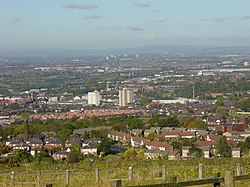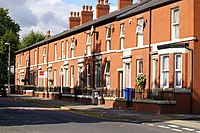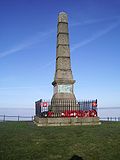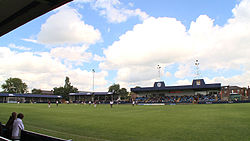Hyde, Cheshire
| Hyde | |
| Cheshire | |
|---|---|
 Hyde from Werneth Low | |
| Location | |
| Grid reference: | SJ945945 |
| Location: | 53°26’51"N, 2°4’55"W |
| Data | |
| Population: | 31,253 (2001) |
| Post town: | Hyde |
| Postcode: | SK14 |
| Dialling code: | 0161 |
| Local Government | |
| Council: | Tameside |
| Parliamentary constituency: |
Stalybridge and Hyde |
Hyde is a town in Cheshire. At the 2001 census, the town had a population of 31,253.. It is 5 miles northeast of Stockport and 7 miles east of Manchester, at the edge of the conurbation of contiguous towns spreading out from the latter city.
Hyde Town Hall dominates the market place area. The large bell in the clocktower is known as Owd Joss (Old Josh), named after Joshua Bradley, a former poor child worker in the mills who later became mayor of Hyde. The clock chimes the Westminster Quarters; the tune famous from "Big Ben" in Westminster, but originating at King's Collage in Cambridge.
Geography
In Werneth Low Country Park is the Hyde War Memorial, maintained by a local trust in memory of the fallen of the two World Wars. The memorial contains 710 names.
Hyde is separated from Denton, Lancashire by the River Tame, a tributary of the River Mersey. There are several areas and suburbs in Hyde, these include, Gee Cross, Newton, Hattersley, Godley, Flowery Field and Kingston.
History
Early history
Newton Hall was present in the 13th century. The area formed a township of the parish of Stockport, St Mary.[1] Its name is derived from the hide, a measure of land for taxation purposes, taken to be that area of land necessary to support a peasant family.[2] In later times it was taken to be equivalent to 120 acres.[2]
In the late 18th century the area that was to become the town centre was no more than a cluster houses known as Red Pump Street. Gee Cross was much larger and 'Hyde' was still only used to refer to the estates of Hyde Hall on the banks of the Tame. Altogether there were only 3,500 inhabitants in the district in 1801. The town is largely a creation of the 19th century and the Industrial Revolution.
Industrial Revolution

The population of Hyde increased due to the success of the cotton mills during the Industrial Revolution of the late 18th and early 19th centuries, at one stage there were 40 working mills. By 1872 only 27 remained, Half of the remaining mills closed between 1921 and 1939 and there is only 1 working mill in the town today. There were many mill owning families, including the Sidebotham, Hibbert and Horsfield families. The main employers in the mills were the Ashton family who successfully ran a combined spinning and weaving company. Most mills concentrated on one process only. The Ashton family built Hyde Chapel on Stockport Road, Gee Cross. The Ashton Brothers' Mill has recently been demolished to make way for a housing estate.
St George's Church was built in 1832 as a chapel of ease to St Mary's, Stockport. It was built at the instigation of John Hyde Clarke of Hyde Hall and was the first Church of England place of worship in the town. St George's became the parish church of part of Hyde township in 1842. Later additions include the lychgate, boathouse by the canal, hearse house, parish rooms and numerous vicarages. The church has a 110-foot tower housing eight bells and a clock.
The Peak Forest Canal was constructed through Hyde from Ashton-under-Lyne to Woodley, Romiley and Marple. Captain Clarke's Bridge, originally named Wood End Canal Bridge, is at the end of Woodend Lane. The bridge was erected before Captain Clarke rose to prominence and therefore probably became known as Captain Clarke's bridge after he retired and resided there.
There was also a coal mine, known as Hyde Colliery, in the town and in January 1889 an explosion there killed 23 miners.[3] There was an enquiry held the following month at the Town Hall.[4] See http://www.cotswan.com/edward_jackson.htm for an account of part of the enquiry. The following month Ardwick AFC, modern day Manchester City, played Newton Heath, modern day Manchester United, under floodlights at Belle Vue to raise money for the victims' families. The game was watched by 10,000 people and this was the first floodlit match played by either side.[5]
20th century

Hyde prospered during the twentieth century, becoming a residential town away from Manchester.
Any genteel reputation of the town has however been stained by an association with two of the most notorious series of murders in the latter twentieth century.
During the 1960s, Myra Hindley and Ian Brady were arrested in their home on the Hattersley Estate in Hyde after police found the body of 17-year-old Edward Evans in the house. At their trial they were found guilty of murdering Evans as well as two other children whose bodies were found buried on Saddleworth Moor several miles away. One of these victims had been killed at Brady and Hindley's house on Wardle Brook Avenue. They later confessed to killing two more children. The house on Wardle Brook Avenue was demolished so that it could never become a sightseeing objective.
In 1998, Dr Harold Shipman, a doctor with his practice in the town, was arrested and revealed to be Britain's most prolific serial killer, and in Hyde he had murdered most of his several hundred victims - the first known victim was 86-year-old Sarah Hannah Marsland of Ashton House in Victoria Street on 7 August 1978 and the last Kathleen Grundy of Joel Lane on 24 June 1998.[6]
Shipman was originally from Nottingham and had lived in Yorkshire before moving to Hyde, while Hindley was originally from the Gorton area of Manchester.[7]
Hyde in fiction
In the BBC television drama Life on Mars, the main character Sam Tyler was said to have transferred from C Division Hyde, to the City Centre, A Division CID. The choice of Hyde is given as a clue that his 1973 self is an alter ego, as in Robert Louis Stevenson's Strange Case of Dr Jekyll and Mr Hyde.[8]
The dance scene from the film Yanks (1979), which starred Richard Gere, was shot in the ball room of Hyde Town Hall.
Sport

- Cricket:
- Hyde Cricket and Squash Club
- Flowery Field Cricket Club
- Football: Hyde FC, founded in 1885 and reformed as Hyde United in 1919, returning to “Hyde FC” in 2010
Outside links
| ("Wikimedia Commons" has material about Hyde, Cheshire) |
References
- ↑ http://www.ukbmd.org.uk/genuki/chs/hyde.html
- ↑ 2.0 2.1 Meaning of the early use of the word "Hide". sizes.com website. Retrieval date: 25 August 2007.
- ↑ James & Mellor (1989), p. 8.
- ↑ The Times 8th, 9th and 16th February 1889.
- ↑ Cawley & James (1991), p. 320.
- ↑ "'Move Shipman's surgery'". BBC News. 24 February 2000. http://news.bbc.co.uk/1/hi/health/655587.stm.
- ↑ "Shipman's 215 victims". BBC News. 13 January 2004. http://news.bbc.co.uk/1/hi/uk/2138888.stm.
- ↑ Life on Mars: The Complete Series One – DVD commentary
Books
- Cawley, Steve; James, Gary (1991). The Pride Of Manchester. Leicester: ACL & Polar. ISBN 0-9514862-1-7.
- Dykes, Garth (1994). The United Alphabet. Leicester: ACL & Polar. ISBN 0-9514862-6-8.
- James, Gary; Mellor, Keith (1989). From Maine Men To Banana Citizens. Nottingham: Temple Press. ISBN 1-870010-08-6.
- James, Gary (1993). Football With A Smile: The Authorised Biography of Joe Mercer, OBE. Leicester: ACL & Polar. ISBN 0-9514862-9-2.
- James, Gary (2008). Manchester A Football History. Halifax: James Ward. ISBN 978-0-9558127-0-5.
